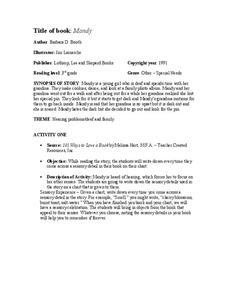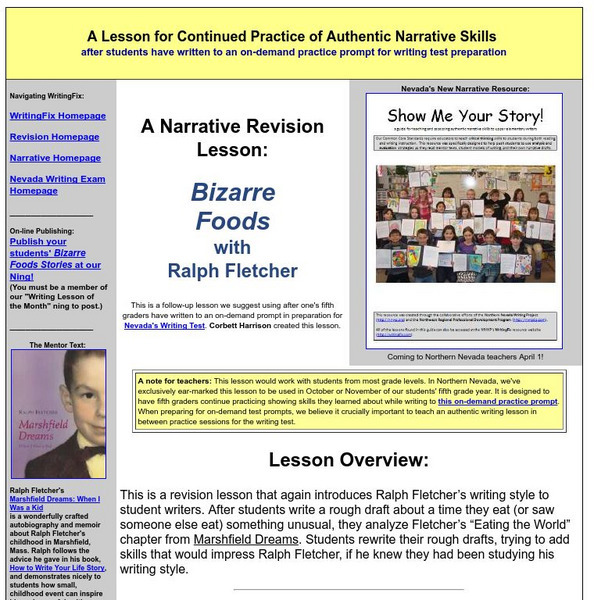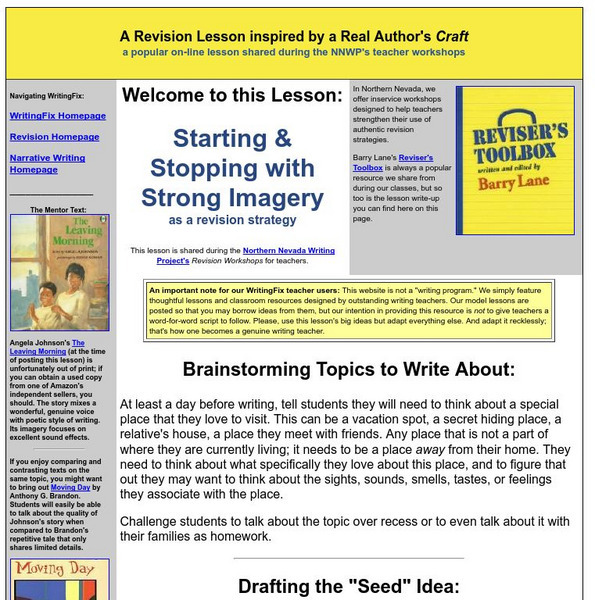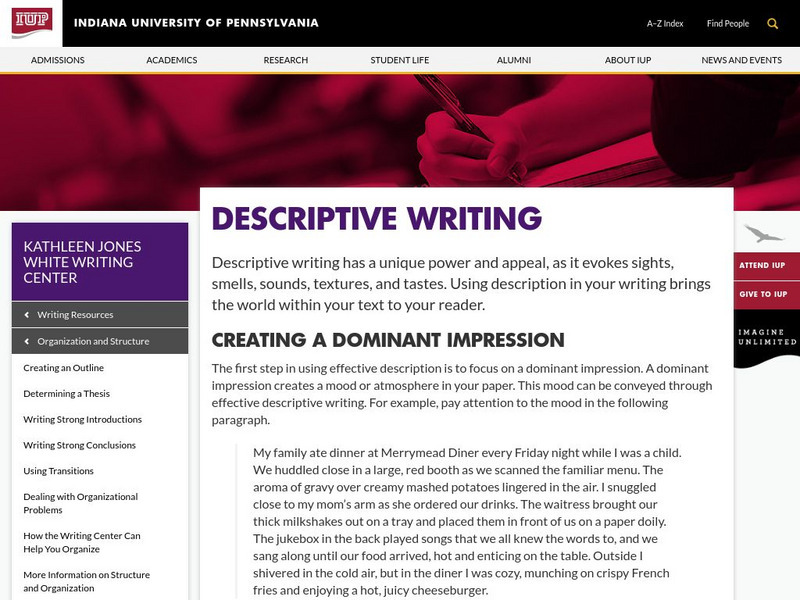Curated OER
Awesome Animals
Sixth graders write descriptive narratives about animals. In this descriptive writing lesson, the teacher models how to write a paragraph with interesting sensory words and exciting verbs. Students choose a picture of an animal they want...
Curated OER
Breaking the Chains: Rising Out of Circumstances
Study history through photographs. In this visual arts and history lesson, students learn to analyze photographs to discover details about life during the Civil War era. Students write journal entries as if they are the African-American...
Curated OER
Color Poems
Students describe colors. In this descriptive writing lesson, students brainstorm color descriptions using all of the senses except sight. Students write poems including similes, sensory images, and interesting word choice. Examples are...
Curated OER
Trees
Students explore tree species based on their features. In this tree lesson, students visit a wooded area and work with a partner to describe distinctive features of trees using all of the senses except "sight." A discovery worksheet is...
Curated OER
Language Arts: Awesome Authors Website
Students examine the writing techniques of professional authors and apply them to their own work. In pairs, they email authors to discover the tricks of the trade. Students create their own Website for their work.
Curated OER
Write, Right
This resource provides the beginning ideas for a instructional activity on writing a narrative. Learners watch a video, identify story elements, including plot and setting, and then write their own stories. If augmented, this...
Curated OER
Poetry: What's on Your Plate (Part 2)
Middle schoolers write a short paragraph using strong descriptions. In this using modifiers lesson, students define modifier, adjective, adverb, metaphor, and simile. Middle schoolers then write a journal entry in which they write...
Curated OER
Lesson Three: Go Free or Die
Fourth graders look for sensory details and figurative language. In this reading strategy lesson, 4th graders read the story Go Free or Die by J. Ferris and complete a chart with figurative language. They use a word wall in the class to...
Curated OER
Every Dog Has Its Day
Students explore the use of imagery in writing. In this writing lesson, students create a writing piece that features sensory images without resorting to the use of clichés.
Curated OER
Sensory Image Chart/Unforgettable Settings
In these sensory image and settings worksheets, students list a book, author, and passage that contains sensory image for the five different senses. Students also read several passages and answer questions about the settings for each.
Curated OER
Mandy
Third graders read Barbara D. Booth's, "Mandy" while noting each time they read a sensory detail. They read about the young girl in the story who is hard of hearing and determine how her other senses are heightened. Also, they determine...
Curated OER
What's On Your Plate?
Young scholars keep running record of the activities they engage in and the food they eat. In this lesson on healthy living, students discuss the dangers of anorexia and bulimia, record their activity level and food consumption over the...
Curated OER
What's On Your Plate?
Students explore the use of sensory details in writing. In this journal writing lesson, students write four journal entries after group discussion about a variety of topics such as their weekend, poverty in the United States, and...
Writing Fix
Writing Fix: Bizarre Foods With Ralph Fletcher: A Narrative Revision Lesson
For this lesson, Ralph Fletcher's writing style is introduced to student writers. Students will write a rough draft about a time they ate, or a time when they saw someone else eat, something unusual. Then students will read and analyze...
Writing Fix
Writing Fix: Starting & Stopping With Strong Imagery: Revision Strategy
In this lesson, students will engage in revising their writings to incorporate sensory images. Students will brainstorm topics of places, away from their home, that are special. Then students will choose and then write a descriptive...
The Write Place
Literacy Education Online
Literacy Education Online (or LEO) is a great place to start if you need help with your writing. The homepage is organized around kinds of problems or questions you might have concerning your writing. Find your problem, click on the...
Texas Education Agency
Texas Gateway: Imagery and Figurative Language (English 7 Reading)
This lesson, focuses on three ways to use figurative language: to create imagery, to appeal to the senses (using sensory detail), and to suggest mood.
Texas Education Agency
Texas Gateway: Imagery (English Iii Reading)
In this lesson, students will learn how writers use words that allow them to create pictures in their heads. When a writer uses sensory details or words that appeal to our senses, then we are able to use our senses and our memory to...
Writing Fix
Writing Fix: The Sum of Its Parts
Inspired by Julianna's understanding (from the novel Flipped by Wendelin Van Draanen) that "A painting is more than the sum of its parts," learners will describe a memorable place that evokes a certain feeling or emotion. Students will...
The Write Place
Literacy Education Online: Sensory Details
This site provides several sample sentences which show sensory details and aid students in writing specific rather than general sentences. It is a good site for someone preparing to write a descriptive essay. W.9-10.3d Precise/sensory...
Other
Indiana Univerisity of Pennsylvania: Writing Center: Descriptive Writing
This website from the Writing Center at Indiana Univerisity of Pennsylvania focuses on descriptive writing. It includes discussion and examples of the following: Creating a dominant impression or mood, using sensory details, using vivid...
Grammar Check
Grammar Check: How to Write a Descriptive Essay
This article provides seven steps to follow when writing a descriptive essay. Ideas for ways to incorporate sensory details are emphasized. W.9-10.3d Precise/sensory details
Other
Study.com: How to Use Descriptive Details & Sensory Language in Your Writing
When you write a narrative, you can draw your reader into your experiences by adding specific, concrete details and sensory language to your storytelling. This lesson tells you exactly how to do it. W.9-10.3d Precise/sensory details,...
Alabama Learning Exchange
Alex: Gummy Worm Writing
This activity is designed to introduce descriptive writing. It can be used in grades 3-5. [Requires Adobe Reader.]

























